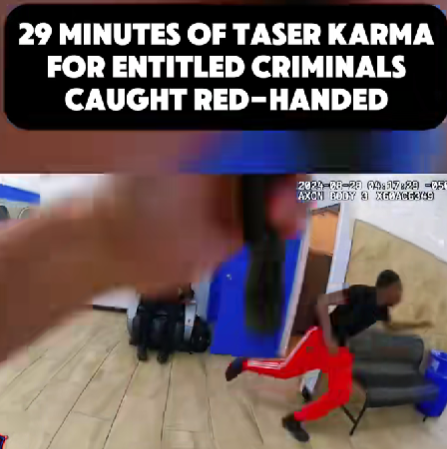A recently released compilation video has gone viral online, showing what many are calling “taser karma” — a series of real-life encounters where suspects tried to flee from law enforcement but quickly learned the hard way that running from the police rarely ends well.
The video, lasting nearly half an hour, strings together bodycam clips from multiple police departments across the country. Each scene captures tense, unpredictable moments where officers attempt to apprehend individuals caught in the act — from theft and trespassing to resisting arrest. But what truly captures viewers’ attention isn’t just the action — it’s the split-second decisions and the consequences that follow.
In one particularly striking clip, a suspect in bright red pants darts through a narrow hallway as officers shout for him to stop. Within seconds, a flash of light and the familiar clicking sound of a taser fill the air. The man collapses to the ground, momentarily stunned, as officers move in to safely restrain him. It’s a scene that has divided audiences — some cheering at the “instant justice,” others questioning the ethics of showcasing such footage for entertainment.
While videos like these draw millions of views, they also open up a deeper discussion about police use of force and accountability. Many experts stress that tasers, while considered non-lethal, are still serious tools that can cause harm if misused. Law enforcement agencies argue that they are often the safest way to de-escalate dangerous situations without resorting to deadly force.
Criminology professor Dr. Aaron Miles explains, “Most officers don’t want a chase. Every pursuit is unpredictable — it puts everyone at risk. When a suspect refuses to comply, tasers can be the difference between a safe arrest and a chaotic confrontation.”
However, critics warn that viral videos can desensitize audiences to real-world suffering, reducing moments of fear and danger into online “entertainment.” Social media platforms are flooded with compilations labeled “karma,” where viewers cheer as suspects are stopped mid-escape. But behind every clip are complex human stories — sometimes involving poverty, mental health issues, or desperation.
The viral nature of such content reflects a growing fascination with justice caught on camera. The combination of adrenaline, authority, and real consequences seems to strike a powerful chord with viewers. “People love to see balance restored,” says media analyst Karen Soto. “It’s the same psychology that makes courtroom dramas and crime shows so popular. But the line between awareness and exploitation is thin.”
As bodycam technology becomes standard for law enforcement nationwide, the number of such clips is only increasing. Some departments release them for transparency, while others condemn their viral spread as trivializing serious incidents.
Whether seen as accountability or spectacle, one thing is certain — the internet’s appetite for “instant karma” moments shows no sign of slowing down. But behind every takedown and every taser spark lies a sobering truth: real people, real mistakes, and real consequences.
